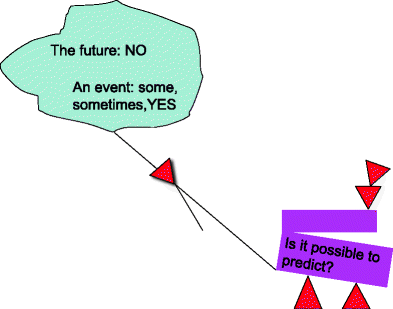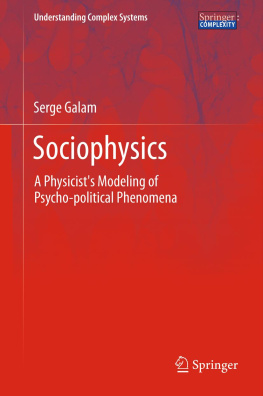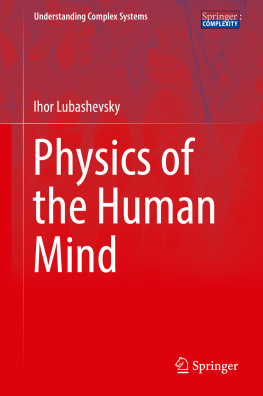Sociophysics deals with one of the most ancient of human dreams, which is simultaneously its nightmare, i.e., the capability to predict and thus to control human behavior. As is often the case, science fiction creates what science will be able to achieve in the future, preceding in part the reality to come. But while succeeding in embodying some of the features of the future, it usually fails to grasp its more fundamental aspects, which is somehow comforting as regards our nonprewritten destiny, which always has many uncertainties.
1.1 Science Fiction and Asimovs Foundation Syndrome
A few years ago, after giving a lecture about some of my work on sociophysics, once the audiences questions were over, on my way out of the auditorium, someone came to me with big shining eyes to ask me if I knew about Hari Seldon, his psychohistory, Foundation, and Asimovs trilogy? This scenario repeated itself a few times in a row.
Each time I was surprised and my answer was polite but somehow negative. I had never heard about this Asimov and his program before, and I think I was a bit reluctant to consider that I might be practicing some science fiction-like ideas. But all these people were telling me in very convinced tones and with great enthusiasm that I should read the novels, since somehow I was doing what the novels main figure, Hari Seldon, does in the Asimov saga. According to my questioners, my sociophysics was identical to his psychohistory.
One more step and I would have become the incarnation of this novels figure; this was a strange feeling for a physicist whose aim was and still is to create a solid science of social behavior. To appear as a novels character was thus a disturbing threat that risked jeopardizing the seriousness of my approach.
Just after these repeated events I went to America to an International Conference and I decided that it was time to check out what was behind these strange and intriguing statements about both my work and my identity. I went to a large bookstore, wearing large wrap-around sunglasses to buy incognito Asimovs first Foundation trilogy (Fig. ).
Fig. 1.1
Hari Seldon is watching me
After an exciting read, I ended up being a bit disappointed, but secure as regards my own construction. First, I understood why these people were making the analogy with me. Then I identified what was similar, indeed very little, and what was different, the main part. However this comparison turned out to be very fruitful since it allowed me to identify the possibilities and the impossibilities associated with the IDEA of quantifying human behavior.
For the sake of both curiosity and clarity, let me first review in short what The Foundation is about. Isaac Asimov is a well known and successful science fiction author who has created many interesting and intriguing worlds that could possibly come true in the future. Among the numerous books he has written stands the trilogy called Foundation with Foundation [].
The central figure is a fictional character called Hari Seldon, a mathematician living in some Galactic Empire. In the course of his research, he envisioned a new field from mathematics that he called psychohistory. The radical content of this novel theory was to embody the possibility of predicting the Galactic Empires future. Thanks to the size of its full population, consisting of billions of individuals, psychohistory was supposed to be able to make predictions using an analogy with the statistical theory of gases.
At first, Seldon had only the formal proof that his program was feasible in principle, but he had no clue as to how to implement the theory in practice. He emphasized this limitation while publicizing his theory at a mathematical conference. Indeed he was pessimistic at that stage about the fact that the practical aspect could not be resolved in the near future. The technical difficulties were tremendous, even if the general theory was mastered.
His incredible program was not yet near to becoming a real scientific field. However, already some politicians became interested and / or scared by the power of the theory. They were proven right since later in the novel, Seldon succeeded in overcoming the technical barrier that made it possible to turn the theory into an efficient predictive political tool.
With the capacity to develop psychohistory into a practical set of equations, he was able to predict the Empires future in terms of probabilities. His prediction was the eventual fall of the Galactic Empire. The whole saga follows from that statement which appeared to be accomplished later in the novel.
1.2 What Makes Sense and What Does Not with Asimovs FictionalPsychohistory
Of course Asimovs psychohistory is a fiction created by a science fiction author and therefore it could seem out of place to discuss it in a serious scientific book. However, it is not superfluous to comment on it since sometimes science fiction, like art, is capable of picking out some features of what will become reality later on. Obviously, not every dream becomes reality, but some do, at least in part. Simultaneously, some realities produce dreams. Let us thus examine what makes sense and what does not in Asimovs vision of the role of mathematics in the course of collective and individual human lives.
1.2.1 Predicting the Future Is Not Possible
Using an analogy with the statistical theory of gases, psychohistory is supposed to be able to predict the future of the whole population of the Galactic Empire consisting of billions of individuals. It relates to the fact that dealing with large numbers of particles results in the averaging out of the initial conditions to result in the existence of macroscopic laws which govern the collective behavior of the ensemble of particles. This is the way it works for gases. The question is then (Fig.):
Fig. 1.2
Predicting the future as against predicting an event: it is not possible to predict the future but sometimes it is feasible to predict an event
Given the hypothesis that it was possible to collect all the information concerning the individuals of a large population, would it become possible to describe its future using some macroscopic quantities and their associated laws of evolution?
In other words, imagining it being possible to store in a huge computer at a given time all the individual characteristics of every person from the whole of the worlds population, knowing in addition their laws of interaction, does this make it possible to calculate, and thus predict, their evolution with time, i.e., their future, their history to come?









